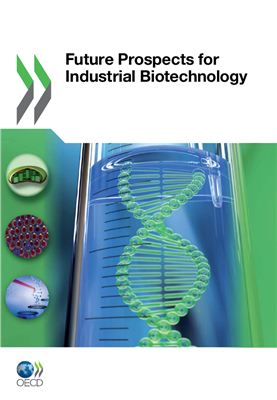Published by OECD. 2011. ISBN 9789264119567 (print). ISBN
9789264126633 (PDF). (142 pages).
Contents : Introduction – Scope and drivers for industrial biotechnology - Emerging synthetic enabling technologies - Trends in industry and products - Current high-visibility industrial biotechnology products - Business organisation and finance in industrial biotechnology - Biotechnology policy – Developments, implications and conclusions.
Industrial biotechnology is a key technology for future economic development. It is the application of biotechnology to the eco-efficient production and processing of chemicals, materials and bio-energy. It utilises the extraordinary capabilities of micro-organisms and enzymes, their
diversity, efficiency and specificity, to make products in sectors such as chemicals, food and feed, pulp and paper, textiles, automotive, electronics and, crucially, energy. Biological processes are generally more environmentally benign than industrial chemical processes as they take place at low
temperature and pressure, have lower energy input requirements and lower greenhouse gas (GHG) emissions. Also, the raw materials for production are renewable, agricultural feedstocks.
Many drivers of industrial biotechnology are clearly linked to the global challenges of climate change, energy security and the financial crisis, yet there are still many barriers to its growth and optimal uptake across industry sectors. Technical barriers are not as daunting as they once were, as biology research is maturing rapidly. Progress in DNA sequencing, strides in proteomics, and the emergence of the field of synthetic biology are leading to unprecedented progress in the biological sciences. When allied to fermentation and biochemical engineering, these form a potent set of enabling technologies to drive the commercialisation of industrial biotechnology.
The outlook for industrial biotechnology is promising owing to the timely convergence of drivers of industrial biotechnology with the unprecedented progress in the biological sciences. The barriers are many, and they have to be tackled through national, regional and inteationally harmonised policy.
Contents : Introduction – Scope and drivers for industrial biotechnology - Emerging synthetic enabling technologies - Trends in industry and products - Current high-visibility industrial biotechnology products - Business organisation and finance in industrial biotechnology - Biotechnology policy – Developments, implications and conclusions.
Industrial biotechnology is a key technology for future economic development. It is the application of biotechnology to the eco-efficient production and processing of chemicals, materials and bio-energy. It utilises the extraordinary capabilities of micro-organisms and enzymes, their
diversity, efficiency and specificity, to make products in sectors such as chemicals, food and feed, pulp and paper, textiles, automotive, electronics and, crucially, energy. Biological processes are generally more environmentally benign than industrial chemical processes as they take place at low
temperature and pressure, have lower energy input requirements and lower greenhouse gas (GHG) emissions. Also, the raw materials for production are renewable, agricultural feedstocks.
Many drivers of industrial biotechnology are clearly linked to the global challenges of climate change, energy security and the financial crisis, yet there are still many barriers to its growth and optimal uptake across industry sectors. Technical barriers are not as daunting as they once were, as biology research is maturing rapidly. Progress in DNA sequencing, strides in proteomics, and the emergence of the field of synthetic biology are leading to unprecedented progress in the biological sciences. When allied to fermentation and biochemical engineering, these form a potent set of enabling technologies to drive the commercialisation of industrial biotechnology.
The outlook for industrial biotechnology is promising owing to the timely convergence of drivers of industrial biotechnology with the unprecedented progress in the biological sciences. The barriers are many, and they have to be tackled through national, regional and inteationally harmonised policy.

